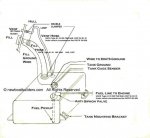The vent line is also there to allow air out of the tank as new fuel is added, and this is where the problems occur. Most vent lines do not take a smooth continuously rising path from tank to vent fitting, they come off the tank, then lay along it for some distance before running up to the vent fitting. Some even must lay down the side of the tank, or run under a bulkhead...
So, what happens is as you're cheerfully driving your boat around, or even if you're stopped to do a bit of fishing, or babe watching, is the fuel continues to slosh around in the tank, some of it goes up the vent hose, and as the hose is laying down, it will remain there. This happens even if the tank isn't overfilled. Even if it's only 3/4 filled, it will do this (ask how I know).... Even if you start the engine and drive home, the fuel in the vent line will not be drawn back into the tank, as the air required to fill the void left by the fuel used in the engine is drawn in so slowly that it just bubbles through the fuel laying in the vent line (ask me how I know this too)....
So, your next stop is the local petrol shop.. Your vent line has a reasonable quantity of fuel trapped in it. You open the fill cap, drop the nozzle in and squeeze the trigger. One of two things will happen, often both. The fuel in the vent line stops enough air from being vented (purpose of the 'vent' line) and fuel in the fill hose is blown back up the fill hose and all over the person holding the nozzle (ask me how I know this one).... The next thing that happens is the operator fills more slowly, and the fuel trapped in the vent line is eventually forced out, and all over the ground, causing the manager to run out with a bucket of sand and a fine for you to pay! (Don't ask me how I know this! :facepalm

Hope this clarifies why I built my 'fuel return canister'....
Chris..........
























